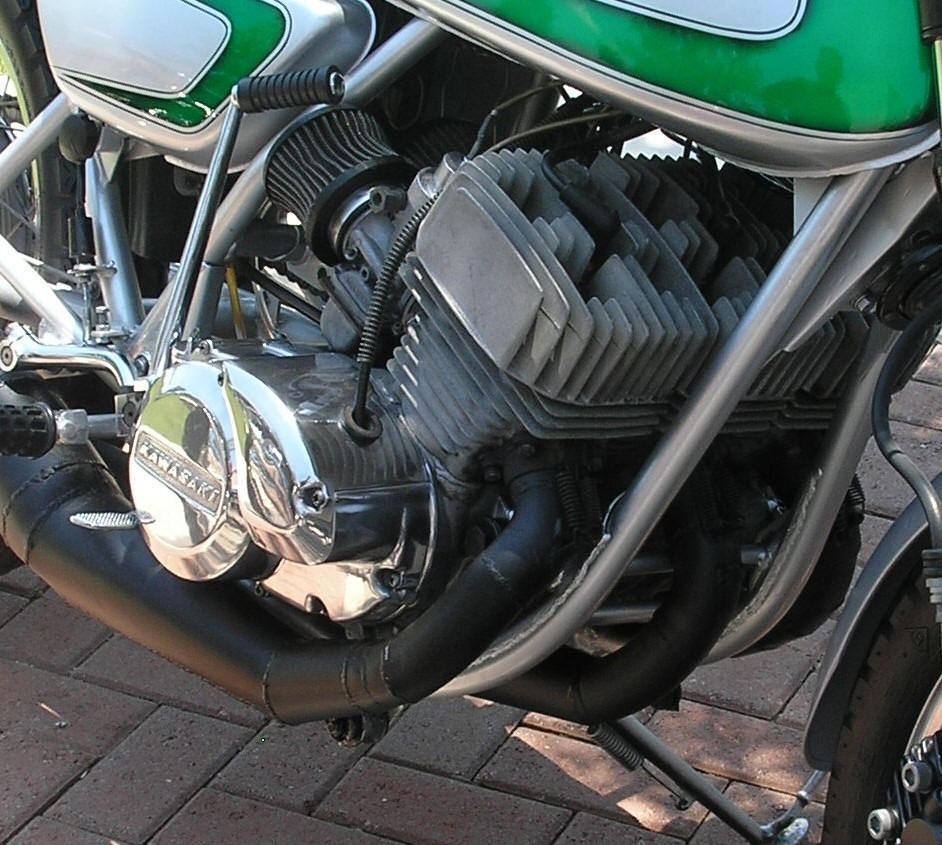
H2R Engine

These cylinders are very late use 1971 and most of
1972 ONLY, NO LATER.
Cylinders are NOT a complete set of first series bridged port H2R
left/center/right, but instead early H2R CENTER cylinders. The flanges on the
two outside cylinders are aimed straight out, something the early outside
cylinders didn't do, they aimed inwards, with the center having a straight shot
out the exhaust ports, reversed from stock outward aimed ports, and they had
fins on the outsides of the outer cylinders..
This engine definitely has 3 early H2R center cylinders on it, and not two
outsiders fitted other side to side.
I remember the name of the owner, but he didn't seem to be a large player in H
series racing, even back then. I think he used to bug, and be a pal of Randy
Hall.
We did a flyer when the H2R's were just about 6 months old, on how to convert an
H1R chassis to use an H2R pieced together from streetbike cylinders setup, with
how to modify the H1R clutch cover and primary gears to fit the H2 engine, and
how to make the top end work in the H1R chassis, with the one main topic being,
either hacksaw the outside fins off two outside streetbike cylinders and swap
them side to side, OR, USE 3 CENTER STREETBIKE CYLINDERS and modify the H1R
frame to clear the straight out exhaust flanges for pipe/frame clearance. I
helped write that flyer, although Randy took all the credit for the three of us
that did the real work.
The cylinders shown should also have altered stud patterns, being real H2R
cylinders and not converted streetbike ones, studs positioned outwards from
stock, for two things, larger front to rear transfer port cuts in the
cases/cylinders, and welded cases for better stud strength in their threaded
holes when the studs were moved. The studs should also be wasted down to the
base diameter of the root diameter of the threads between the threaded ends, for
strength, AND stock H2 head nuts, drilled all the way through the head of the
nut, for lightening.
The inlet port manifold flanges on early first series H2R cylinders should also
accept inlet manifolds with four stud holes as well, as these were used on the
first series H2R cylinders ONLY, straight off the H1RA and H1RA-S engines, with
the same 35mm carbs the H1R's used.
Early H2R's that used these cylinders were the only
ones with altered stud locations. Those cases should not have the added in
welding in the rear of the crankshaft tunnels under the carbs, that wasn't done
until late 1973. Early first series altered stud location H2R cases and 3
center first series H2R intake and exhaust bridged, altered stud cylinders.
The numbers pad is flat, correct for an early set of cases, and if you look
closely at the right hand cylinder's front stud location on the cases, you can
see the added welding on the base gasket pad, indicative of the altered cylinder
stud locations.
What I also see are later model (early 1973) tall top carbs, a predecessor to
the smooth bores. These carbs in the pic have the H1R/H2R link plate across the
float bowls, and the stabilizer shaft across the tops of the bodies. They use a
hollow slide that fits over the smooth bore insert in the carb bore. They, as
the magnesium H2R carbs, are very rare these days.